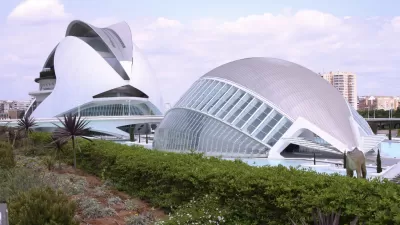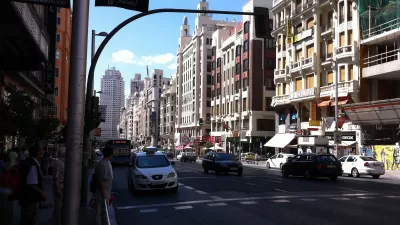In Valencia, workers will begin removing the sparkling mosaic facade that adorns the Queen Sofía Palace of the Arts today. The opera house's crumbling facade is the latest episode to tarnish architect Santiago Calatrava's professional reputation.
When it comes to Santiago Calatrava's City of Arts and Sciences complex in Valencia, the news just keeps getting worse. The latest episode involves the Queen Sofía Palace of the Arts, "which has been closed since last month because of a risk of falling tiles" from its mosaic facade, reports Raphael Minder. This week, construction workers are to begin removing the opera house's entire facade.
The massive complex was supposed to help the architect's native city become an architectural showpiece. Instead, the gleaming white campus has become a financial albatross for the city and a dark spot on Calatrava's reputation.
"Mr. Calatrava covered the opera house with thousands of tiny mosaic tiles, using a technique made famous over a century earlier by Antoni Gaudí in Barcelona," explains Minder. "But the Valencia authorities threatened to sue Mr. Calatrava last month after chunks fell off in high winds, forcing the closing of the building ahead of Christmas performances and the cancellation next month of Puccini’s 'Manon Léscaut,' directed by Plácido Domingo."
"Instead of replacing the mosaic tiles, the building is to be painted white, at least as a temporary solution to allow the opera to reopen and resume its season late next month," he adds.
FULL STORY: Spanish Opera House to Lose Crumbling Facade by Star Architect

Maui's Vacation Rental Debate Turns Ugly
Verbal attacks, misinformation campaigns and fistfights plague a high-stakes debate to convert thousands of vacation rentals into long-term housing.

Planetizen Federal Action Tracker
A weekly monitor of how Trump’s orders and actions are impacting planners and planning in America.

In Urban Planning, AI Prompting Could be the New Design Thinking
Creativity has long been key to great urban design. What if we see AI as our new creative partner?

King County Supportive Housing Program Offers Hope for Unhoused Residents
The county is taking a ‘Housing First’ approach that prioritizes getting people into housing, then offering wraparound supportive services.

Researchers Use AI to Get Clearer Picture of US Housing
Analysts are using artificial intelligence to supercharge their research by allowing them to comb through data faster. Though these AI tools can be error prone, they save time and housing researchers are optimistic about the future.

Making Shared Micromobility More Inclusive
Cities and shared mobility system operators can do more to include people with disabilities in planning and operations, per a new report.
Urban Design for Planners 1: Software Tools
This six-course series explores essential urban design concepts using open source software and equips planners with the tools they need to participate fully in the urban design process.
Planning for Universal Design
Learn the tools for implementing Universal Design in planning regulations.
planning NEXT
Appalachian Highlands Housing Partners
Mpact (founded as Rail~Volution)
City of Camden Redevelopment Agency
City of Astoria
City of Portland
City of Laramie




























